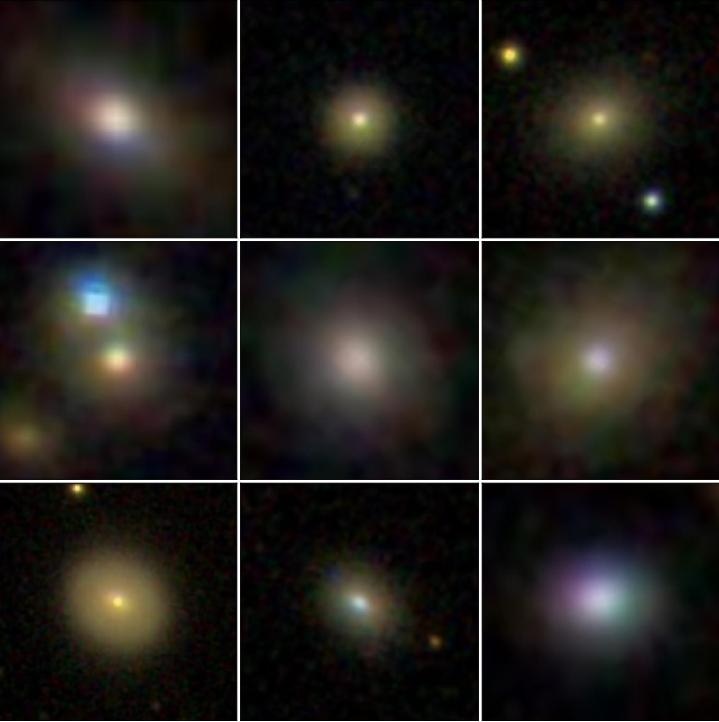Oct 14 2019
A study by astronomers from the University of California, Riverside, has revealed that strong winds induced by supermassive black holes at the centers of dwarf galaxies have a considerable effect on how these galaxies evolve by suppressing the formation of stars.
 Dwarf galaxies hosting active galactic nuclei that have spatially extended outflows. (Image credit: SDSS)
Dwarf galaxies hosting active galactic nuclei that have spatially extended outflows. (Image credit: SDSS)
Dwarf galaxies are tiny galaxies consisting of about 100 million to a few billion stars. On the contrary, the Milky Way contains around 200 to 400 billion stars. Being the most copious types of galaxies in the universe, dwarf galaxies usually orbit larger galaxies.
The group of three astronomers was astonished by the strength of the observed winds.
We expected we would need observations with much higher resolution and sensitivity, and we had planned on obtaining these as a follow-up to our initial observations. But we could see the signs strongly and clearly in the initial observations. The winds were stronger than we had anticipated.
Gabriela Canalizo, Professor of Physics and Astronomy, UC Riverside
According to Canalizo, who led the research group, in the last couple of decades, astronomers have visualized the supermassive black holes at the centers of large galaxies to have an intense impact on the growth and aging of large galaxies.
“Our findings now indicate that their effect can be just as dramatic, if not more dramatic, in dwarf galaxies in the universe,” she added.
The outcomes of this study have been reported in The Astrophysical Journal.
The researchers—including Laura V. Sales, an assistant professor of physics and astronomy, and Christina M. Manzano-King, a doctoral student in Canalizo’s lab—made use of a part of the data from the Sloan Digital Sky Survey.
This survey involves mapping over 35% of the sky, to detect 50 dwarf galaxies, of which 29 galaxies exhibited signs of being related to black holes at their centers. Of these 29 galaxies, 6 exhibited proof of winds—particularly, high-velocity ionized gas outflows—discharged from their active black holes.
“Using the Keck telescopes in Hawaii, we were able to not only detect, but also measure specific properties of these winds, such as their kinematics, distribution, and power source—the first time this has been done,” stated Canalizo. “We found some evidence that these winds may be changing the rate at which the galaxies are able to form stars.”
According to Manzano-King, the first author of the study, several unsolved questions related to galaxy evolution could be perceived by analyzing dwarf galaxies.
“Larger galaxies often form when dwarf galaxies merge together,” she noted. “Dwarf galaxies are, therefore, useful in understanding how galaxies evolve. Dwarf galaxies are small because after they formed, they somehow avoided merging with other galaxies. Thus, they serve as fossils by revealing what the environment of the early universe was like. Dwarf galaxies are the smallest galaxies in which we are directly seeing winds—gas flows up to 1,000 kilometers per second—for the first time.”
Manzano-King elucidated that material falling into a black hole gets heated up because of friction and powerful gravitational fields, thus releasing radiative energy. Ambient gas from the galaxy’s center is pushed outward by this energy into intergalactic space.
What’s interesting is that these winds are being pushed out by active black holes in the six dwarf galaxies rather than by stellar processes such as supernovae. Typically, winds driven by stellar processes are common in dwarf galaxies and constitute the dominant process for regulating the amount of gas available in dwarf galaxies for forming stars.
Christina M. Manzano-King, Doctoral Student, UC Riverside
Astronomers assume that when wind discharged from a black hole is pushed outward, the gas ahead of the wind is compressed by it, thus increasing the formation of stars. However, in case the entire amount of wind is evicted from the center of the galaxy’s, there is a dearth in the available gas, thus leading to a decrease in star formation. As detected by the researchers, the latter is what appears to be taking place in the six dwarf galaxies.
In these six cases, the wind has a negative impact on star formation. Theoretical models for the formation and evolution of galaxies have not included the impact of black holes in dwarf galaxies. We are seeing evidence, however, of a suppression of star formation in these galaxies. Our findings show that galaxy formation models must include black holes as important, if not dominant, regulators of star formation in dwarf galaxies.
Laura V. Sales, Assistant Professor of Physics and Astronomy, UC Riverside
Going forward, the researchers intend to analyze the mass and momentum of gas outflows in dwarf galaxies.
“This would better inform theorists who rely on such data to build models,” stated Manzano-King. “These models, in turn, teach observational astronomers just how the winds affect dwarf galaxies. We also plan to do a systematic search in a larger sample of the Sloan Digital Sky Survey to identify dwarf galaxies with outflows originating in active black holes.”
The study was funded by the National Science Foundation, NASA, and the Hellman Foundation. Data was acquired at the W. M. Keck Observatory, and made possible by financial support from the W. M. Keck Foundation.